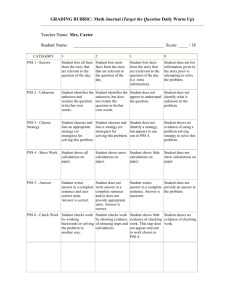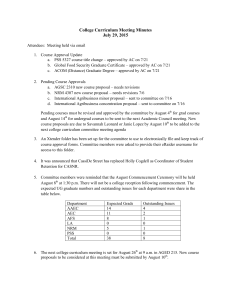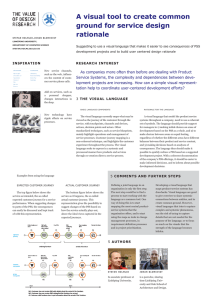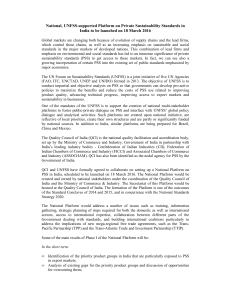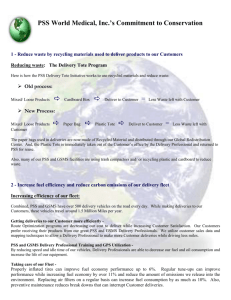Tuning of PSS and AVR using Genetic power system
advertisement
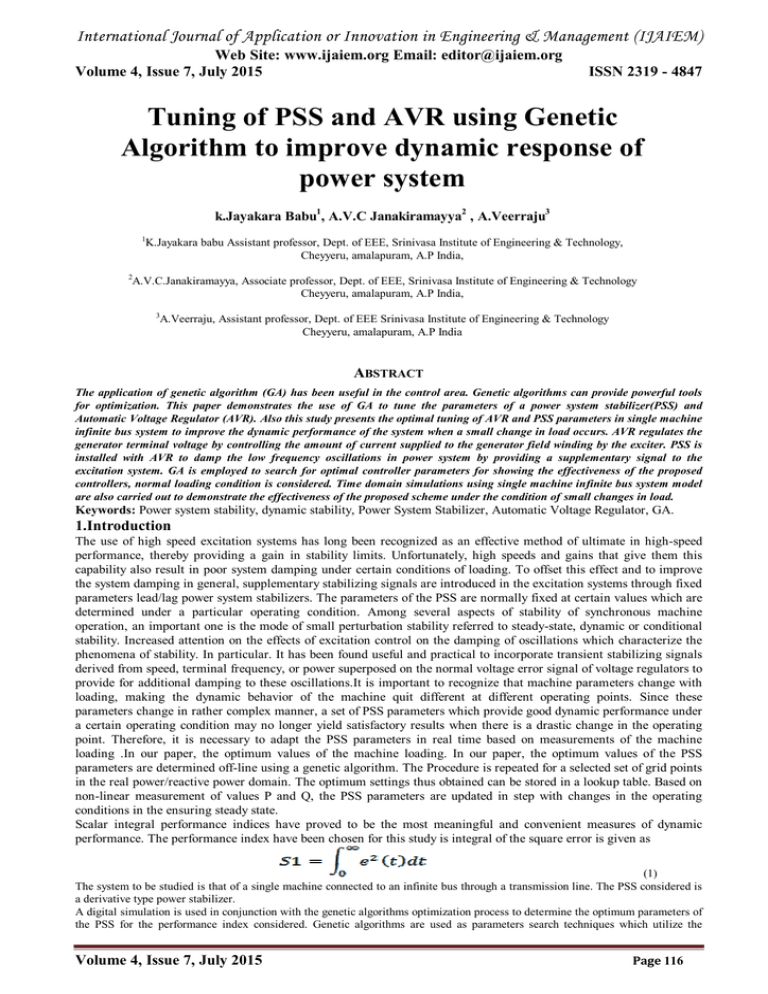
International Journal of Application or Innovation in Engineering & Management (IJAIEM) Web Site: www.ijaiem.org Email: editor@ijaiem.org Volume 4, Issue 7, July 2015 ISSN 2319 - 4847 Tuning of PSS and AVR using Genetic Algorithm to improve dynamic response of power system k.Jayakara Babu1, A.V.C Janakiramayya2 , A.Veerraju3 1 K.Jayakara babu Assistant professor, Dept. of EEE, Srinivasa Institute of Engineering & Technology, Cheyyeru, amalapuram, A.P India, 2 A.V.C.Janakiramayya, Associate professor, Dept. of EEE, Srinivasa Institute of Engineering & Technology Cheyyeru, amalapuram, A.P India, 3 A.Veerraju, Assistant professor, Dept. of EEE Srinivasa Institute of Engineering & Technology Cheyyeru, amalapuram, A.P India ABSTRACT The application of genetic algorithm (GA) has been useful in the control area. Genetic algorithms can provide powerful tools for optimization. This paper demonstrates the use of GA to tune the parameters of a power system stabilizer(PSS) and Automatic Voltage Regulator (AVR). Also this study presents the optimal tuning of AVR and PSS parameters in single machine infinite bus system to improve the dynamic performance of the system when a small change in load occurs. AVR regulates the generator terminal voltage by controlling the amount of current supplied to the generator field winding by the exciter. PSS is installed with AVR to damp the low frequency oscillations in power system by providing a supplementary signal to the excitation system. GA is employed to search for optimal controller parameters for showing the effectiveness of the proposed controllers, normal loading condition is considered. Time domain simulations using single machine infinite bus system model are also carried out to demonstrate the effectiveness of the proposed scheme under the condition of small changes in load. Keywords: Power system stability, dynamic stability, Power System Stabilizer, Automatic Voltage Regulator, GA. 1.Introduction The use of high speed excitation systems has long been recognized as an effective method of ultimate in high-speed performance, thereby providing a gain in stability limits. Unfortunately, high speeds and gains that give them this capability also result in poor system damping under certain conditions of loading. To offset this effect and to improve the system damping in general, supplementary stabilizing signals are introduced in the excitation systems through fixed parameters lead/lag power system stabilizers. The parameters of the PSS are normally fixed at certain values which are determined under a particular operating condition. Among several aspects of stability of synchronous machine operation, an important one is the mode of small perturbation stability referred to steady-state, dynamic or conditional stability. Increased attention on the effects of excitation control on the damping of oscillations which characterize the phenomena of stability. In particular. It has been found useful and practical to incorporate transient stabilizing signals derived from speed, terminal frequency, or power superposed on the normal voltage error signal of voltage regulators to provide for additional damping to these oscillations.It is important to recognize that machine parameters change with loading, making the dynamic behavior of the machine quit different at different operating points. Since these parameters change in rather complex manner, a set of PSS parameters which provide good dynamic performance under a certain operating condition may no longer yield satisfactory results when there is a drastic change in the operating point. Therefore, it is necessary to adapt the PSS parameters in real time based on measurements of the machine loading .In our paper, the optimum values of the machine loading. In our paper, the optimum values of the PSS parameters are determined off-line using a genetic algorithm. The Procedure is repeated for a selected set of grid points in the real power/reactive power domain. The optimum settings thus obtained can be stored in a lookup table. Based on non-linear measurement of values P and Q, the PSS parameters are updated in step with changes in the operating conditions in the ensuring steady state. Scalar integral performance indices have proved to be the most meaningful and convenient measures of dynamic performance. The performance index have been chosen for this study is integral of the square error is given as (1) The system to be studied is that of a single machine connected to an infinite bus through a transmission line. The PSS considered is a derivative type power stabilizer. A digital simulation is used in conjunction with the genetic algorithms optimization process to determine the optimum parameters of the PSS for the performance index considered. Genetic algorithms are used as parameters search techniques which utilize the Volume 4, Issue 7, July 2015 Page 116 International Journal of Application or Innovation in Engineering & Management (IJAIEM) Web Site: www.ijaiem.org Email: editor@ijaiem.org Volume 4, Issue 7, July 2015 ISSN 2319 - 4847 genetic operators to find near-optimal solutions. The advantage of the GA technique is that it is independent of the complexity of the performance index considered. It suffices the objective function and to place finite bounds on the optimized parameters. 2. SYSTEM MODEL Fig.2.1 single machine connected to an infinite bus The system considered in this paper a synchronous machine connects to an infinite bus through a transmission line, as shown in fig.2.1. The synchronous machine is described by a fourth-order model. 3. Control Schematic Diagram of Power System Stabilizer The dynamic stability of a system can be improved by providing suitably tuned power system stabilizers on selected generators to provide damping to critical oscillatory modes. Suitably tuned Power System Stabilizers (PSS), will introduce a component of electrical torque in phase with generator rotor speed deviations resulting in damping of low frequency power oscillations in which the generators are participating. The input to stabilizer signal may be one of the locally available signal such as changes in rotor speed, rotor frequency, accelerating power or any other suitable signal. This stabilizing signal is compensated for phase and gain to result in adequate component of electrical torque that results in damping of rotor oscillations and thereby enhance power transmission and generation capabilities. State-space techniques described under Dynamic Stability Studies or classical control theory such as Bode plots, root locus techniques can be used to determine suitable parameters for power system stabilizers.The design can then be verified with a transient stability analysis for practical system disturbances. Fig. 3.1 Structure of PSS By increasing the gain, the act of damping will be better. The formula that gives the value of PSS gain is as follow: (2) The number of lead lag compensators depended on the amount of phase lag of AVR and generator field circuit. The relations in the block diagram shown in fig. 2.2. Apply to a two axis machine representation with a field circuit in the direct axis but without damper windings. The interaction between the speed and the voltage control equations of the machine is expressed in terms of six constants k1-k6.These constants with the exception of k3, which is lonely a function of the ratio of the impedance, are dependent upon the actual real and reactive power loading as well as the excitation levels in the machine. Volume 4, Issue 7, July 2015 Page 117 International Journal of Application or Innovation in Engineering & Management (IJAIEM) Web Site: www.ijaiem.org Email: editor@ijaiem.org Volume 4, Issue 7, July 2015 ISSN 2319 - 4847 Fig. 3.2 system block diagram 4. SYSTEM MATHEMATICAL MODELING EQUATIONS: The equations describing the steady-state operation of a synchronous generator connected to an infinite bus through an external reactance can be linearized about any particular point as follows. (3) (4) (5) (6) The constants K1-K6 are obtained from the reference paper and they are given below: (7) (8) Volume 4, Issue 7, July 2015 Page 118 International Journal of Application or Innovation in Engineering & Management (IJAIEM) Web Site: www.ijaiem.org Email: editor@ijaiem.org Volume 4, Issue 7, July 2015 ISSN 2319 - 4847 5. APPLICATION OF GENETIC ALGORITHM TO PSS Genetic Algorithm (GA) is a global optimization algorithm derived from evolution and natural selection. Although genetic algorithm cannot always provide optimal solution, and is a powerful tool for solving complex problems. GA includes operations such as reproduction, crossover, and mutation. Selection is a process in which a new generation of population is formed by selecting the fittest individuals in the current population Crossover is the most dominant operator in GA. It is responsible for producing new offsprings by selecting two strings and exchanging portions of their structures. The new offsprings may replace the weaker individuals in the population. Mutation is a local operator which is applied with a very low probability. Its function is to alter the value of a random position in a string. The application of a genetic algorithm involves repetitively performing the steps: 1. The calculation of the performance index for each of the individuals in the current population. To do this, the system must be simulated to obtain the value of the performance index. 2. The genetic algorithm then produces the next generation of individuals using the selection, crossover and mutation operators. These two steps are repeated from generation to generation until the population has converged, producing the optimum pentameters. The procedure is then repeated for the selected set of grid points in the real power/reactive power domain (P=0.1, 0.2………., 1.0; Q=-0.3,-0.2, .1.0); 5.1 SIMULATION RESULTS It is clear that the optimal settings of the PSS parameters vary widely with the operating point and also depend on the performance index being minimizes. Simulation tests for various operating points and with the GA computed optimum parameters settings were performed. A step like disturbance in mechanical power as used to perturb the system form its operating point. The traces shown in this chapter for speed deviations and they are of three types: 1. PSS disconnected 2. With PSS before applying genetic algorithm 3. With PSS after applying genetic algorithm The optimum parameters when a unit step disturbance in mechanical power was used to perturb the system from its operating point with the range of P=0.1 and Q=1.0 From the results it is clear that 1. The PSS considered significantly increases the stability of the system 2. Altering the PSS parameters to cope with real/reactive power loading maintains optimum performance for a wide range of system considerations Because of the simplicity of using the GA with complex objective functions and non-linear systems and other performance indices and full system representations are being currently investigated. In order to verify the above values of the K and T, the simulation results are considered below. Fig. 5.2 simulation diagram with PSS before applying GA Volume 4, Issue 7, July 2015 Page 119 International Journal of Application or Innovation in Engineering & Management (IJAIEM) Web Site: www.ijaiem.org Email: editor@ijaiem.org Volume 4, Issue 7, July 2015 ISSN 2319 - 4847 Fig. 5.3 simulation diagram with PSS after applying GA 0.2 0.15 Delta w 0.1 0.05 0 -0.05 -0.1 -0.15 0 20 40 60 80 100 120 140 160 180 Time Fig. 5.4Waveform of speed deviation for P, Q without stabilizer 0.2 0.15 0.1 Delta w 0.05 0 -0.05 -0.1 -0.15 -0.2 0 20 40 60 80 100 120 140 160 180 Time Fig. 5.5 Waveform of speed deviation for P, Q with stabilizer before GA Volume 4, Issue 7, July 2015 Page 120 International Journal of Application or Innovation in Engineering & Management (IJAIEM) Web Site: www.ijaiem.org Email: editor@ijaiem.org Volume 4, Issue 7, July 2015 ISSN 2319 - 4847 0.1 0.08 delta w 0.06 0.04 0.02 0 -0.02 0 5 10 15 20 25 time 30 35 40 45 50 Fig. 5.6 Waveform of speed deviation for P, Q with stabilizer after GA 18 16 Rotor angle(Delta) 14 12 10 8 6 4 2 0 0 20 40 60 80 Time 100 120 140 160 Fig. 5.7 Waveform of rotor angle deviation for P, Q without stabilizer 25 Rotor angle(D elta) 20 15 10 5 0 0 20 40 60 80 100 120 140 160 180 Time Fig. 5.8 Waveform of rotor angle deviation for P, Q with stabilizer before GA 7 6 Rotor angle (Delta) 5 4 3 2 1 0 0 20 40 60 80 100 120 140 Time Fig. 5.9 Waveform of rotor angle deviation for P, Q with stabilizer after GA Volume 4, Issue 7, July 2015 Page 121 International Journal of Application or Innovation in Engineering & Management (IJAIEM) Web Site: www.ijaiem.org Email: editor@ijaiem.org Volume 4, Issue 7, July 2015 ISSN 2319 - 4847 6.Conclusion The tuning of power system stabilizers (PSS) using genetic algorithms (GA) is investigated in this paper. A digital simulation of a linearized model of a single machine infinite bus power system at some operating point is used in conjunction with the genetic algorithm optimization process. The performance index integral of the square of the error is considered. For the performance index, the PSS parameters are optimized offline for a selected set of grid points of the real power/reactive power (P/Q) domain. It is suggested that PSS parameters be updated based on measurements of the generator real and reactive power. Time domain simulations of the system with GA tuned PSS show the improved dynamic performance under widely varying load conditions. References [1] P.Kundur. "Power System Stability and Control", Mc. Graw Hill 1994. [2] P. M. Anderson, and A. A. Fouad, “Power System Control and Stability”, IEEE Press 1994. [3] A. R. Messina, J. M. Ramirez, and J.M. C. Canedo, “An investigation on the use of power system stabilizers for damping inter-area oscillations in longitudinal power systems,” IEEE Trans. Power Syst., vol. 13, no. 2, pp. 552– 559, May 1998. [4] M. Klein, G. J. Rogers, and P. Kundur, “A fundamental study of interarea oscillations in power systems,” IEEE Trans. Power Syst., vol. 6, no. 3, pp. 914–921, Aug. 1991. [5] P. Kundur, “Effective use of power system stabilizers for enhancement of power system reliability,” in Proc. IEEE Power Eng. Soc. Summer Meeting , vol. 1, pp. 96–103, Jul. 1999. [6] EL-Zonkoly, A.M. „Optimal tuning of power systems stabilizers and AVR gains using particle swarm optimization , International Journal of Expert Systems with Applications (Vol. 31(939)). pp. 551–557, 2006. AUTHOR K. JAYAKARA BABU received the B.E in Electrical Engineering from SIR C.R REDDY COLLEGE OF ENGINEERING in 2006 and 2010, And received M.Tech in Power & Industrial Drives from G.M.R INSTITUTE OF TECHNOLOGY in 2011-2013, His research interests are power quality, operation and stability, FACTS, Optimization techniques applied to power systems, Volume 4, Issue 7, July 2015 Page 122

